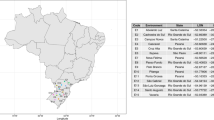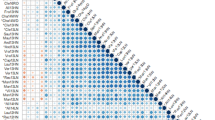Summary
The joint durum wheat (Triticum turgidum L var ‘durum’) breeding program of the International Maize and Wheat Improvement Center (CIMMYT) and the International Center for Agricultural Research in the Dry Areas (ICARDA) for the Mediterranean region employs extensive multilocation testing. Multilocation testing produces significant genotype-environment (GE) interaction that reduces the accuracy for estimating yield and selecting appropriate germ plasm. The sum of squares (SS) of GE interaction was partitioned by linear regression techniques into joint, genotypic, and environmental regressions, and by Additive Main effects and the Multiplicative Interactions (AMMI) model into five significant Interaction Principal Component Axes (IPCA). The AMMI model was more effective in partitioning the interaction SS than the linear regression technique. The SS contained in the AMMI model was 6 times higher than the SS for all three regressions. Postdictive assessment recommended the use of the first five IPCA axes, while predictive assessment AMMI1 (main effects plus IPCA1). After elimination of random variation, AMMI1 estimates for genotypic yields within sites were more precise than unadjusted means. This increased precision was equivalent to increasing the number of replications by a factor of 3.7.
Similar content being viewed by others
References
Crossa J, Gauch HG, Zobel RW (1990) Additive main effects and multiplicative analysis of two international maize cultivar trials. Crop Sci 30:493–500
Crossa J, Fox PN, Pfeiffer WH, Rajaram S, Gauch HG (1991) AMMI adjustment for statistical analysis of an international wheat yield trial. Theor Appl Genet 81:27–37
Eberhart SA, Russell WA (1966) Stability parameters for comparing varieties. Crop Sci 6:36–40
Finlay KW, Wilkinson GN (1963) The analysis of adaptation in a plant breeding programme. Aust J Agric Res 14:742–754
Gauch HG (1988) Model selection and validation for yield trials with interaction. Biometrics 88:705–715
Gauch HG (1990) Full and reduced models for yield trial. Theor Appl Genet 80:153–160
Gauch HG, Zobel RW (1988) Predictive and postdictive success of statistical analyses of yield trials. Theor Appl Genet 76:1–10
Gauch HG, Zobel RW (1989) Accuracy and selection success in yield trial analyses. Theor Appl Genet 77:473–481
Gauch HG, Zobel RW (1990) Imputing missing yield trial data. Theor Appl Genet 79:753–761
Gollob HF (1968) A statistical model which combines features of factor analytic and analysis of variance techniques. Psychometrika 33:367–376
Kempton RA (1984) The use of the bioplots in interpreting variety by environment interactions. Biometrics 88:705–715
Krzanowski WJ (1983) Cross-validatory choice in principal components analysis — some sampling results. J Stat Computation and Simulation 18:299–314
Nachit MM (1986) Durum wheat improvement. In: Varma S (ed) Cereal improvement program 1986. ICARDA Publ 145 EN, Aleppo, Syria, pp 78–101
Tukey JW (1949) One degree of freedom for non-additivity. Biometrics 5:232–242
Wold S (1978) Cross-validatory estimation of the number of components in factor and principal components models. Technometrics 20:397–405
Wright AJ (1971) The analysis and prediction of some two factor interactions in grass breeding. J Agric Sci 76:301–306
Zobel RW, Wright AJ, Gauch HG (1988) Statistical analysis of a yield trial. Agron J 80:388–393
Author information
Authors and Affiliations
Additional information
Communicated by J. Mac Key
Rights and permissions
About this article
Cite this article
Nachit, M.M., Nachit, G., Ketata, H. et al. Use of AMMI and linear regression models to analyze genotype-environment interaction in durum wheat. Theoret. Appl. Genetics 83, 597–601 (1992). https://doi.org/10.1007/BF00226903
Received:
Accepted:
Issue Date:
DOI: https://doi.org/10.1007/BF00226903




